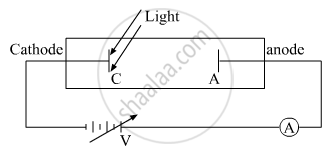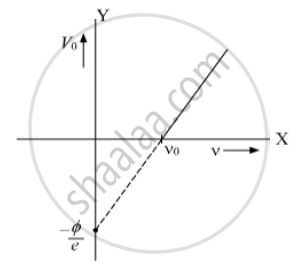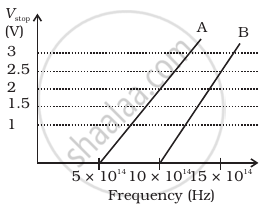Advertisements
Advertisements
प्रश्न
Define the terms (i) ‘cut-off voltage’ and (ii) ‘threshold frequency’ in relation to the phenomenon of photoelectric effect.
Using Einstein’s photoelectric equation shows how the cut-off voltage and threshold frequency for a given photosensitive material can be determined with the help of a suitable plot/graph.
उत्तर
When light of sufficiently small wavelength is incident on a metal surface, electrons are ejected from the metal. This Phenomenon is called the photoelectric effect.

(i) The cathode is illuminated with light of some fixed frequency v and fixed Intensity I1. A small photoelectric current is observed due to few electrons that reach anode just because they have sufficiently large velocity of emission. If we made the potential of the anode negative with respect to cathode then the electrons emitted by cathode are repelled. Some electrons even go back to the cathode so that the current decreases. At a certain value of this negative potential, the current is completely stopped. The least value of this anode potential which just stops the photocurrent is called cut off potential or stopping potential.
(ii) For a given material, there is a certain minimum frequency that if the incident radiation has a frequency below this threshold, no photoelectric emission will take place, howsoever intense the radiation may be falling.
(iii) According to Einstein’s photoelectric equation, maximum K. E is given as
`K.E_(max) =(hc)/lambda phi = hv -phi`
Where λ is wavelength and ν is corresponding frequency and Φ is work function.
We expose a material to lights of various frequencies and thus photoelectric current is observed and cut off potential needed to reduce this current to Zero is noted. A graph is plotted and that is straight line.
At ν0 the stopping potential is zero this means at this frequency the incident light is not able to eject electrons this is threshold frequency. Extended this line gives the cut off potential to make the photo
current zero which is `(-phi)/e`

संबंधित प्रश्न
Write Einstein’s photoelectric equation?
point out any two characteristic properties of photons on which Einstein’s photoelectric equation is based ?
Is p − E/c valid for electrons?
The electric field at a point associated with a light wave is `E = (100 "Vm"^-1) sin [(3.0 xx 10^15 "s"^-1)t] sin [(6.0 xx 10^15 "s"^-1)t]`.If this light falls on a metal surface with a work function of 2.0 eV, what will be the maximum kinetic energy of the photoelectrons?
(Use h = 6.63 × 10-34J-s = 4.14 × 10-15 eV-s, c = 3 × 108 m/s and me = 9.1 × 10-31kg)
A monochromatic light source of intensity 5 mW emits 8 × 1015 photons per second. This light ejects photoelectrons from a metal surface. The stopping potential for this setup is 2.0 V. Calculate the work function of the metal.
(Use h = 6.63 × 10-34J-s = 4.14 × 10-15 eV-s, c = 3 × 108 m/s and me = 9.1 × 10-31kg)
How does one explain the emission of electrons from a photosensitive surface with the help of Einstein’s photoelectric equation?
A student performs an experiment on photoelectric effect, using two materials A and B. A plot of Vstop vs ν is given in Figure.

- Which material A or B has a higher work function?
- Given the electric charge of an electron = 1.6 × 10–19 C, find the value of h obtained from the experiment for both A and B.
Comment on whether it is consistent with Einstein’s theory:
Radiation of frequency 1015 Hz is incident on three photosensitive surfaces A, B and C. Following observations are recorded:
Surface A: no photoemission occurs
Surface B: photoemission occurs but the photoelectrons have zero kinetic energy.
Surface C: photo emission occurs and photoelectrons have some kinetic energy.
Using Einstein’s photo-electric equation, explain the three observations.
A photon of wavelength 663 nm is incident on a metal surface. The work function of the metal is 1.50 eV. The maximum kinetic energy of the emitted photoelectrons is ______.
The photon emitted during the de-excitation from the first excited level to the ground state of a hydrogen atom is used to irradiate a photocathode in which the stopping potential is 5 V. Calculate the work function of the cathode used.
